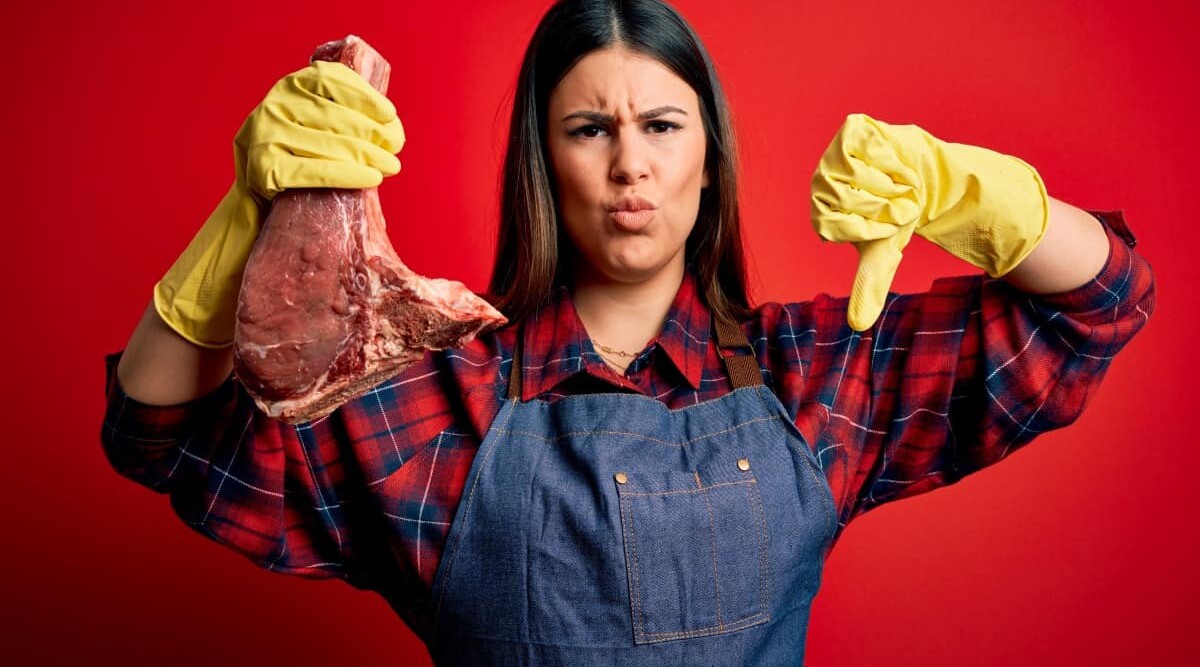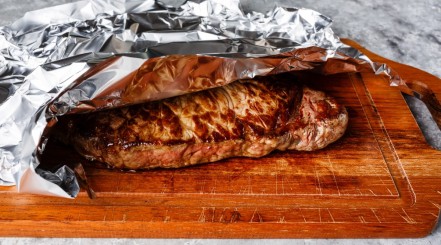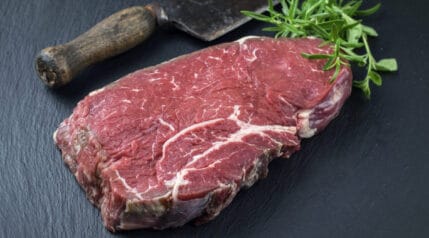
Today’s topic: recognizing the signs of a steak that’s gone bad and how to stop it from happening — or, at least, how to delay it.
The thrill of anticipation is one of the best feelings there is. Sometimes, it’s as exciting as the event itself. Like getting ready for a vacation, taking a big sniff of a pie baking in the oven, or licking a bit of sauce off your fingers before you tuck into a rack of ribs.
The flip side of that coin is the horror of discovering that thing you’ve been anticipating ain’t going to happen. Choose your expletive and use it here.
If you love grilling steaks, you know all about anticipation. Hopefully, you’ve never had to experience finding your steak has gone bad. (But, if you’re reading this, there’s probably a reason.)
To spare you from the agony of having to throw out a bad steak (or trying to digest one!), I’m going to teach you the signs to look for. Plus, I’ll share tips for storage in the fridge and freezer, and how to keep your steaks fresh for as long as possible.
By the end of this guide, you’ll know how to tell if your steak is only fit for the compost or if it’s still good to go on the grill.
Follow your nose to the first sign of a good steak gone bad.
Jump to:
A Bad Smell — Somewhat Cheesy
Ah, the old sniff test! Some smells are obvious indicators of food that’s past its prime. We’ve all done it on yogurt, sandwich meat, socks — you name it. But what about steaks?
If you suspect your raw steak is past its prime, take a whiff — what do you smell? It should have a slightly metallic smell. It’s not necessarily appetizing in and of itself, but it’s not stomach-turning, either.
Steak that’s gone off typically has a powerful smell that will curl your nose hairs. The exact smell may vary, but a cheesy odor is a common description. And not a good cheese, either.
Others describe the stank of steak as being like ammonia, rotten eggs, or just generally “sour.”
It’s important to note that dry-aged steak naturally smells a bit like cheese because of lactic acid concentration in the muscle fibers. Fortunately, there’s more than one way to tell if your steak is better off in the garbage than on the grill.
Discoloration
Picture a perfect raw steak in your mind. Is it dark red with a bit of white marbling? Of course it is. That’s the classic image we’ve all seen in ads, cartoons, movies, and so on.
But, if your raw steak isn’t red, is it bad?
Not necessarily.
There’s a commonly held notion that if your steak has turned partially brown or gray, it’s no good. Color change in raw beef may be caused by exposure to oxygen, and it’s not a big deal. A few spots of gray or brown are not always indicators that steak is bad.
However, if there is a LOT of brown or gray, it may be too late for this particular cut. Likewise, spots of green or yellow strongly suggest it’s best to bin it.
Slimy to the Touch
A good raw steak should be moist to the touch. But, if there appears to be a film on the surface, it may be a sign of steak that’s seen better days.
Run a clean finger across the steak. If it feels slimy or slick, that’s a solid warning sign your steak is off. Whether it is or isn’t slimy, be sure to wash your hands after doing the touch test.
Use-by Date Has Passed
A geologist I know (ok, he’s my big brother) once commented on how daft it is to put a “use by” or “best before” date on salt. Salt from mines might be millions of years old — it should probably be ok in your pantry for a few years.
This is not the case with steak, which is highly perishable no matter how you store it.
Check the package for a “sell-by” or “use-by” date.
The sell-by date is the last day the retailer can sell the steak and give the customer sufficient time to cook and enjoy it.
The use-by date (or “best before” date) is the last day on which it’s likely safe to consume the steak. Typically, that’s a few days after the sell-by date.
That doesn’t mean your steak is for sure no good the day after the use-by date. Or even the day of. It’s just another indicator to help you make a decision.
If the “use-by” date sneaks up on you, and you don’t have an opportunity to cook the steak, store it by wrapping it up tightly and put it in the freezer until you’re ready.
It’s Dried Out
I mentioned earlier that a good raw steak should be moist. It will also be soft and squishy to the touch. The opposite is true of a steak that’s gone bad; it will be dried up and firm and perhaps sitting in a pool of its own lost juices.
While a dry steak may not be “bad” in a harmful way, it’s almost certainly going to be tasteless and chewy after cooking unless the marbling is phenomenal. You might be better off not wasting your time on a dry steak.
Be aware of the difference between dried out and dry-aged; dry-aged steaks are hung to dry in a controlled environment, losing some moisture but gaining a ton of flavor. Don’t toss out your expensive dry-aged steaks because they don’t feel moist — they aren’t supposed to!
Mold
Unless we’re talking about certain kinds of cheese, mold is rarely a good sign on your food.
There is a lot of confusing, sometimes contradictory information about moldy meat out there. Some say you can scrape it off, while others say you can cut that part off. Others still, say a little of mold probably won’t hurt you.
As for me, I fall into the “when in doubt, throw it out” school of thought.
Yes, your digestive system (if it’s healthy) can indeed deal with certain kinds of mold without you ever knowing about it. On the other hand, some strains of mold can be dangerous. You could end up violently ill. In very rare cases, ingesting mold can be fatal.
Why risk it? At the first sign of mold, I highly recommend pitching the steak and making something else for dinner.
How to Keep Your Steaks Fresh
You can’t prevent the inevitable — steak will spoil eventually, despite the stories you may have heard about people eating mammoth meat found in the arctic tundra.
But, that doesn’t mean there aren’t ways to keep your prized steaks fresh and ready for as long as possible.
Store fresh meat in the fridge to prolong its “use-by” date. If it comes pre-wrapped in plastic, leave it in there until you’re ready to use it; grocery store meat is often packed with pumped-in CO2 to delay the growth of microbes and to puncture the plastic releases that outer defense.
Steak from a butcher, however, usually gets wrapped up in pink paper before it’s handed over.
If it’s not tightly wrapped, either re-wrap it yourself or drop the whole thing into a large freezer-safe bag. Force as much air out as possible, and seal it up. (You could also use a vacuum sealer for the ultimate airless storage.)
Get the steak into the fridge as soon as possible. And be sure your fridge temperature is set for no higher than 40F. (I keep mine at 38F.)
If you can, store your steak as close to the back of the fridge as possible for consistently cool temperatures. Cooling can be uneven in a fridge, especially with the door opening and closing repeatedly.
Frequently Asked Questions on How to Tell if Steak Has Gone Bad
Here are some quick answers to the top questions about bad steak, including why it happens and if it’s a big deal or not.
What Happens if You Eat Bad Steak?
Steak that has spoiled may contain harmful mold, bacteria, or toxins. While many are benign or can be taken care of by the digestive system, there is always a risk of becoming sick.
Bad steak may also taste bad. While a bad taste won’t lead to illness, it will lead to disappointment.
Will Defrosting and Refreezing Steak Cause it to Go Bad?
If a frozen steak is safely defrosted, it’s ok to refreeze it for future consumption. The safest way to defrost a steak is to leave it in its wrappings and place it in the refrigerator until it’s thawed. By keeping the steak consistently under 40F, you remove the opportunity for harmful bacteria to form.
If you decide not to cook a defrosted steak, move it back to the freezer ASAP, and maintain an airtight seal on the packaging to protect it from freezer burn.
Be aware that, while safely defrosting a steak and then refreezing won’t make it go bad, it may negatively impact the flavor when you do cook it.
How Long Can Steak Stay in the Fridge?
See our article on how long raw steak can stay in the fridge for a deep discussion on this. But the main takeaway is that fresh steak that’s properly wrapped is typically safe to store in the fridge for 3 to 5 days, according to the USDA. That’s not a hard and fast rule; it may be good for longer under ideal conditions.
However, always carefully inspect any meat you’ve had in storage before cooking it.
Cooked steak may be kept in the fridge for up to 4 days if tightly wrapped.
How Long Can You Freeze a Steak?
The answer depends greatly on how well your steak is wrapped, and how consistently your freezer holds its temperature.
Under ideal conditions, a frozen steak should be safe to thaw, cook, and eat for up to one year. Wrapping should be airtight, and a chest freezer in a climate-controlled environment (i.e. not in your shed or on a porch) is the best device for long-term storage.
It’s a good idea to write the date you put a steak in the freezer on the outside of the packaging. Think of it as your personal “use-by” date; this should prevent any accidental discoveries of prehistoric meat at the bottom or back of the freezer.
What Causes Steak to Change Color?
A pigment in steak (and other meat) called myoglobin gives it a dark red or purplish color. Exposure to oxygen transforms myoglobin into oxymyoglobin, which imparts more of a cherry hue to meat. To our eyes, that color equals delicious, so stores use oxygen-permeable plastic wrap to help it hold the cherry color.
Soon, though, prolonged exposure to oxygen and light changes oxymyoglobin into metmyoglobin. This is when steak starts to turn grayish-brown due to oxidation thanks to iron in the myoglobin.
Can Eating Off Steak Make You Sick?
Eating bad steak won’t necessarily make you sick, but the potential is there. Serious pathogens, including staphylococcus, E. Coli, and salmonella can be found in or on bad steak.
Bacteria like these can cause serious illness and may even be life-threatening, especially to children and the elderly. And cooking meat at high temperatures does not guarantee to kill these bacteria.
Final Thoughts
When it comes to how to tell if steak is bad, it’s always best to err on the side of caution. Your health, and the health of your family and guests, isn’t worth the risk, no matter how much the steak cost.
Hopefully, this article will help you make an educated decision, should the need ever arise. Hopefully, it never does — we hate to see a tasty steak go to waste!
We’ve got lots more information on steaks, including how to store them and how to cook them, for you to explore. Use the search tool or open the Knowledge tab and let the learning begin.
As always, we thank you for choosing us to help you with all your grilling questions. Be sure to spread the word; tell your friends about us and join us on Facebook or Instagram.
Cheers and happy grilling!






Hi, thanks for the info. Just one thing I noticed that I wanted to clear up. You implied that a “best before” date is the same as a “use by” date. In the UK at least, they are very different. A “best before” date is a suggestion, letting you know the quality of a product may deteriorate after this date, but it won’t actually poison you. However, a “use by” date is an instruction, because after this date a product may make you ill.
Hi Rita. That’s a valid and important distinction, thank you for adding that!